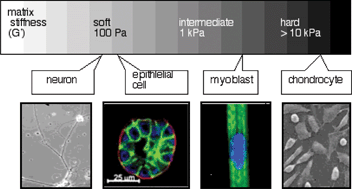Soft biological materials and their impact on cell function†
Abstract
Most organs and biological tissues are soft viscoelastic materials with elastic moduli ranging from on the order of 100 Pa for the brain to 100 000 Pa for soft cartilage. Biocompatible synthetic materials already have many applications, but combining chemical compatibility with physiologically appropriate mechanical properties will increase their potential for use both as implants and as substrates for tissue engineering. Understanding and controlling mechanical properties, specifically softness, is important for appropriate physiological function in numerous contexts. The mechanical properties of the substrate on which, or within which, cells are placed can have as large an impact as chemical stimuli on cell morphology, differentiation, motility, and commitment to live or die.

- This article is part of the themed collection: Cells and proteins at interfaces

 Please wait while we load your content...
Please wait while we load your content...